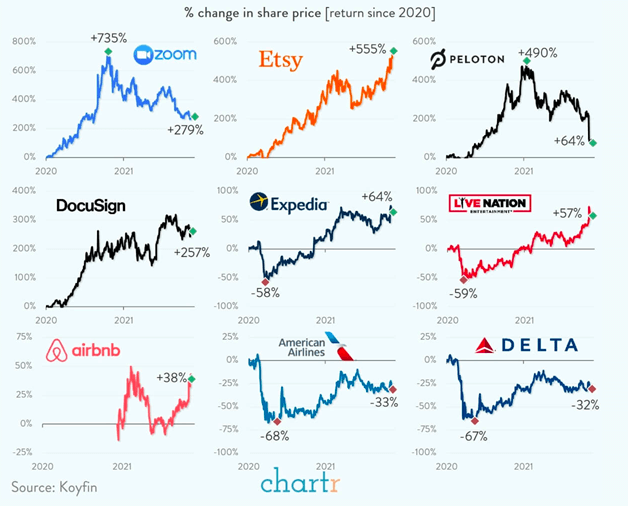
Our Digital Marketing Predictions for 2022 - What Does the Future Hold?

By Lee Colbran|8 Dec 2021
Digital Marketing | 15 MIN READ
Seriously, where did 2021 go? It only feels like yesterday that we put together our predictions for this year, let alone reaching December and now putting together our thoughts for 2022.
Now, as 31 December draws ever nearer, we asked team members to look toward the future and share their thoughts on what might happen in the year ahead in the world of digital.
Without further ado, predictions from our team members for 2022 include:
- The lines between agency and clients will blur further
- Increased use of digital things
- It's all about me
- The need to consider emotional needs when designing solutions
- 2022 will see the next generation of social signals
- The headwinds of share prices
- Relevancy will be crucial
- 2022 is going to be a year for machine learning and automation
- Businesses that don't embrace rapid change will die
The lines between agency and clients will blur further
Melissa Waters - Head of Client Services
I predict that 2022 will further blur the lines between agency and client, moving even closer to a partnership mentality with working relationships.
The closer ties will take the idea of true integration with the agency being an extension of the client team to the next level, which is very positive.
By embracing this shift and allowing agencies to become an extension of the client team, both can produce brilliant work together.
Melissa Waters, Head of Client Services

By being forced to move in-person relationships online, the pandemic has created a more efficient and personal way to work with clients and has created a greater level of trust;
- We create efficiencies because we can be selective about our in-person meetings. Sometimes contact is more frequent and more focused - for example, a daily “huddle” instead of a long meeting.
- We have come to know our clients more personally through remote working and supporting each other, and now we know their extended family, friends, homes, and pets (and they have got to know us better too).
- Our clients can trust that we have proven ourselves to work alongside them, not for them, no matter the challenge. As a result, there is a coming together of minds and purpose.
By embracing this shift and allowing agencies to become an extension of the client team, both can produce brilliant work together, which we wholeheartedly welcome, and 2022 may be the year we see this flourish.
Increased use of digital things
David Somerville - Strategy Director
Last year my colleague Libby wrote about how the pandemic has fundamentally changed customer behaviour across all demographics/generations and how this would continue into 2021.
I would start by saying I believe this has been the case, with anecdotal evidence of seeing my parents use many more online services in the past year, even after restrictions ended. They admit that it’s often quicker and easier, plus more convenient, once they’ve mastered how to do it.
My prediction is related to this in that I feel that where businesses have offered alternative digital versions of existing offline services, there will be increased usage of these services. However, a significant shift now is that consumers will become even more critical if the entire customer journey does not reflect the same benefits and positive experience that the digital part delivers.
Consumers will become even more critical if the entire customer journey does not reflect the same benefits and positive experience that the digital part delivers.
David Somerville, Strategy Director

We know there’s been a wave of businesses such as restaurants, pubs, and supermarkets implementing online ordering, which is a positive experience in most cases. For example, you can choose at your own pace, order at different times to others in your group (which helps split the bill for those particular about that). You can even pay with a range of different options - all in just a couple of clicks. However, the experience is often marred by many factors, such as the food being poor, the service being slow, the delivery driver being late or missing food items.
A cognitive bias called the ‘peak-end rule’ impacts how humans remember past events. We heavily place the intensely positive or negative moments (the “peaks”) and the final moments of an experience (the “end”) in our mental calculus. People might well have a positive ‘peak’ to start, but if followed by some negative peaks or end, then overall, their opinion of that business or brand is sadly going to be tainted.
While this concept of providing excellent customer experience across the ‘customer journey’ is not new, the fact that peoples’ expectations are rapidly changing makes it even more critical for organisations to get it right in 2022 (and beyond).
It's all about me
Libby Toscano - Project Director
Based on David's prediction (see above), I think 2022 will see an ever-growing focus on customer data and actionable insights for better personalisation. It's more important than ever to create experiences that meet customers' needs, and personalisation will be critical to that.
The pandemic saw more consumers shopping online, their need for simpler and faster services became the norm. And to keep up with expectations, brands advanced to meet their ever-demanding needs. But as brands raced to promote their products and services, the focus now needs to turn to meeting those individual needs and making consumers feel 'it's all about me'.
Customers want a personalised experience no matter what channel they use. They expect brands to understand and respond to their individual needs regardless of devices and channels.
Libby Toscano, Project Director

Don't you love it when you turn on Netflix, and it recommends what you should watch next? Netflix collects and utilises data about their customers to suggest what they like to watch. Perfect for the time-poor customer. Customers want a personalised experience no matter what channel they use. They expect brands to understand and respond to their individual needs regardless of devices and channels. So a seamless omnichannel approach goes hand-in-hand with personalisation. We can say the same for B2B. Unique dashboards can be personalised to customers with product recommendations based on their data and bespoke content that meets their needs that can help offer solutions and advice. All this helps build loyal customers and should be a crucial part of plans for 2022.
So as we move into next year, we will see consumer expectations continue to grow. We will see them want something unique to them. Emails need to go beyond just using the recipient's first name in the message. Instead, customers value product promotions, recommendations and reminders based on their specific actions, all whilst appearing as if a real person sent it.
Consumers want it to be 'all about me'.
The need to consider emotional needs when designing solutions
Luke Hay - User Research Director
Last year I predicted that there would be a continued increase in remote user research. I was hardly sticking my neck out on that one, as inevitably it proved to be the case.
Over the year, we ran around 100 remote moderated research sessions across different research methods. This year I think the trend will broadly continue, but hopefully, we'll start to see a bit more 'in-person' testing as things, hopefully, return to something closer to 'normal'.
Aside from that, I'd like to think user researchers will be making more effort to be more in touch with their users in the coming year. Now more than ever, we should consider the emotional states and well-being of the people we are designing for.
User researchers will need to show more consideration for participants during user research and consider users' mental states when designing solutions.
Luke Hay, User Research Director

As user researchers, we generally try to 'do right' by our users, but after the past year or two, we need to do better than that.
We need to consider that the effects of the pandemic have put an enormous toll on the mental health of millions of people. Issues like accessibility have become even more significant than before. With people locked down, unable to, or unwilling to travel, we've seen online services go from a convenient alternative to a 'must have'. This trend is true for everyday services, like supermarket shopping and tools like Zoom, which have become a real lifeline for some in a disconnected world.
User researchers will need to show more consideration for participants during user research and consider users' mental states when designing solutions.
So, for 2022 we'll be making more of a concerted effort to consider 'user needs' and the impact that our design decisions will have on the mental well-being of those who use our clients' products and services.
2022 Will see the next generation of social signals
Stephen Courtney
According to a survey by Brightlocal, 52% of consumers would refuse to use a business with less than four stars. When presented with a panoply of seemingly indistinguishable options, customers rely on social signals to help them choose.
Unfortunately, trust in online reviews and ratings is at an all-time low, which is why 2022 will see business websites embracing new forms of social context.
Marketers are acutely aware of the power that group dynamics have on consumer choice. Solomon Asch’s classic 1956 studies on conformity demonstrate the persuasive influence of consensus, whilst Mathew Salganik’s more recent work on artificial cultural markets shows how the illusion of popularity can alter personal preferences. These group effects are exaggerated by the ambiguities of online shopping, which is why social signals have become such a dominant feature of the digital marketplace.
Industry-leading platforms like Amazon prioritise social signals and often give star ratings greater prominence than price. Not only do A/B tests validate such decisions, but cross-sectional studies highlight the fundamental role of reviews and ratings in guiding customers. The probability of a sale peaks sharply when product ratings fall within a particular band (one study places this between 4.2 and 4.5 stars), and consumers attest to paying more for products with better reviews. These points explain why businesses invest heavily in customer feedback and, at the same time, why some have tried to game the system.
The new generation of social signals will require far greater transparency and detail, earning consumer trust through rigor rather than brand authority.
Stephen Courtney, CRO and UX Strategist

Repeated investigations by the consumer watchdog Which? have uncovered millions of fake reviews on commercial platforms like Amazon, eBay, and TripAdvisor. Similar research by the BBC has shown how the services of digital review farms are openly traded online, and an article published in October 2021 described how a made-up Facebook business was able to collect over 600 fake reviews in a single week. With so much fraudulent content polluting the online marketplace, customers have started to doubt the integrity of familiar social signals.
The disruption is a huge obstacle for challenger brands who rely on word of mouth. Crucially, it also threatens the leverage of major eCommerce platforms whose scale allows them to relay unmatched volumes of customer feedback. Because of this, 2022 will see new forms of social context introduced throughout online marketplaces.
The new generation of social signals will require far greater transparency and detail, earning consumer trust through rigor rather than brand authority. Reviews will include verified timestamps and unique authenticating details, whilst ratings platforms will compete on the basis of integrity. New forms of social signals will begin to appear, with real-time visitor counts, event notifications and stock updates enriching the UI language of online stores. This added richness, fidelity and immediacy will bring the digital experience one step closer to real-world shopping.
The headwinds of share prices
Julian Erbsloeh - Strategy Director
When businesses worldwide went into a tailspin in early 2020, nobody could predict the impact of the looming pandemic across multiple industries.
We suspected that travel would be in trouble. We knew that Amazon, Google and food delivery services would probably benefit from it, but what about the rest? And what are our prospects for next year, knowing now that ‘back to normal’ is an abstract and wishful concept of the future but not reality?
Looking at how some of the most talked-about companies’ share prices developed since the pandemic helps us understand how these industries were affected and what their outlook will look like in the future.

Ultimately in unpredictable times like these, share prices are not only an indicator of current financial stability but a vote of confidence in future performance.
Zoom, the video conferencing software, and Peloton, the home cycle fitness company, were two of the hottest traded shares when we started to realise how our lives would be impacted by working and exercising from home. However, the pandemic boost did not last for these two companies, whether that was because of a high level of competition or the realisation that working out alone at home on expensive equipment was not as much fun as we thought!
Ocado, the UK online supermarket, falls into the same bracket, with initial excitement wearing off as competitors offered better service and booking delivery slots seven days in advance turned out to be too much of an ask for the customer.
For 2022, think beyond updating your social responsibility policy and start re-inventing your products and services with your customers as well as sustainability in mind. The brave will reap the rewards!
Julian Erbsloeh, Strategy Director

The chart that got me thinking was Etsy. The online marketplace for vintage gifts and homemade crafts initially saw investors show confidence in its ability to grow through the pandemic, very much like Zoom and Peloton. They also sold an incredible amount of face masks, attracting new users to the platform. When it became more apparent that we probably would not be sitting at home forever, Etsy started to ride on another, more recent market trend - sustainability. In this instance, let’s use it as an umbrella term for caring about the environment, small independent traders, the quality of the goods you purchase and the people around you!
People on furlough started looking for ways to make a little income with crafty projects. Still, Etsy’s valuation is not so much based on turnover but the growth of their customer base as an indicator for future success. So, while the platform saw total active buyers (1 purchase in 12 months) jump by 30% YoY, habitual buyers (6 purchases and min $200 spend) jumped by 65%! That’s a triumph of understanding longer-term changes in user preference over short term needs (life in lockdown) and a sign of what consumers care about when buying a product.
I am inherently biased regarding sustainability and have developed my environmental conscience into overdrive over the past year. And I know that I am not alone in that, even outside of my filter bubble and personalised news feeds.
While every organisation has a social responsibility to care about this stuff, the more compelling argument for marketers is that their customers really care about this, creating enormous opportunities for early adopters to stand out from their competitors and reap the rewards. Not all industries have seen sustainable disrupters succeed, so think about what you can do in your business and your industry to show that your brand is willing to change the world.
For 2022, think beyond updating your social responsibility policy and start re-inventing your products and services with your customers as well as sustainability in mind. The brave will reap the rewards!
Relevancy will be crucial
Stephen Jones - Senior SEO Manager
A prediction for 2022 is simply building on what Google has stated since its creation: relevancy.
It now has ‘hundreds of billions’ of indexed pages and needs to find out the best results to show in top search positions. To do this, it runs machine-learning processes to determine the intent of a search query and patents going back several years to measure and gauge customer engagement. It is increasingly able to see what is a satisfactory result for a query and whether users find their ‘first choice’ result clicks useful or not. Top results are continually tested with newly-discovered domains and pages to determine if better sites are available to display.
Progressively developed for user experience, Google Search Console now highlights pages that provide a good customer experience and flags URLs with performance or accessibility issues that will annoy visitors.
Assuming that Google is better at determining what people are looking for and whether a ‘quick dip’ into a page solves their search need (or not). It’s amazing to see how often large blocks of traffic are written off as ‘not valuable’ simply because it doesn’t convert to a core KPI or business objective.
This search traffic could be doing other things on a website, all of which would be sending valuable signals to Google that the domain provided interest and value to visitors (even if it wasn’t some kind of direct purchase). Unfortunately, poor content, bad architecture and confusing UX often hasten a user’s departure rather than guiding them to another page of interest.
Unfortunately, poor content, bad architecture and confusing UX often hasten a user’s departure rather than guiding them to another page of interest.
Stephen Jones, Senior SEO Manager

Using a bricks and mortar analogy, one customer popping into a shop, peering at an item and then leaving isn’t a disaster. But when that’s hundreds (or even thousands) of customers each month, at what point do you, the shopkeeper, get out from behind the counter and go and ask them if they need help?
Not everyone will be a buyer, but some will. Others may be interested in something they didn’t even come in for if you suggest it.
From a digital perspective, this is simply the ‘one more click’ tactic. We can test out one suggested objective against another until we find something that encourages these visitors to stick around and do more, instead of haemorrhaging from a landing page and sending questionable quality signals about the site.
Now our ‘useless’ traffic is undertaking page testing for us and making the site more helpful for customers. In turn, search engines should pick this up and see relevancy for different search intent (and hopefully reward us with better or consistent organic search positioning).
2022 is going to be a year for machine learning and automation
Nate Wood - Strategy Director
For me, 2022 will be a year for machine learning and automation.
Throughout the last 12-18 months, we've seen a big push on consolidation of activity in platforms, removal of human-required segmentation to cluster assets and targeting to enable machine learning to see the whole picture and therefore be able to make more informed decisions.
Google is giving obvious signals that they see machines doing a far better job than people. The release of Performance Max campaigns to all advertisers, the change to responsive ads as default in Feb this year, the retirement of expanded text ads in June 2022 and an ongoing narrative of bigger budget caps controlled by algorithmic targets rather than a human mandate.
Marketing automation is relatively well established, with many marketers taking advantage of automation to complete everyday tasks. However, there's a new kid in town: marketing orchestration.
Nate Wood, Strategy Director

Marketing automation is relatively well established, with many marketers taking advantage of automation to complete everyday tasks. However, there's a new kid in town: marketing orchestration. Orchestration uses a centralised pool of data to make automated, informed decisions across multiple automated processes. Whereas the individual automated processes might be like individual musicians, marketing orchestration brings those processes together to create outstanding user experiences.
Orchestration enables a much more holistic approach to digital, connecting otherwise disparate channel journeys to produce a more seamless and personalised experience. The rise of automation, machine learning and orchestration will drive marketers to adopt new skills in 2022 and beyond.
The work will move away from the microtasks of daily optimisation as marketers become less "hands-on" and require a more holistic oversight and direction. Analytical skills will be instrumental in helping marketers to set targets for algorithms to work towards.
2022 will also see marketers investing more time in understanding how to survive and thrive in a cookie-less world. First-party data has been increasing in importance for some time, and 2022 will see marketers attempting to gather FPD even more as the cookie crunch looms in 2023.
We'll need to understand in more detail what is possible and where. Performance analysis will need to adapt significantly, and we may see more comparative and incrementality testing to understand the impact of marketing.
Businesses that don’t embrace rapid change will die.
Callum Grantham
Mass use of the internet is barely 20 years old. The number of users increased tenfold from 1999 to 2013, and what we use it for has changed completely.
But history has not ended.
How we live is changing, how we access information is changing – everything is changing and organisations must change with it.
Businesses that continue with their ideas about the world ten years ago - with activity and budget organised using 20th-century departmental notions – will fail.
Separate budgets for digital, brand, service departments and the rest made sense when those activities could be packaged and measured discretely. But organisations can no longer expect structures to stay fit for purpose for years and decades at a time.
It might not seem long since the first iPhone release in 2007, but the extent of change over the subsequent 14 years is enormous.
Much was made of businesses’ rapid adoption of technologies during the pandemic. The mistake is thinking of this speed change as a one-off. Better technology enables faster change, and the state of the world makes further shocks inevitable.
If they want to survive 2022 (and beyond), businesses will need to embrace rapid change.
Callum Grantham, Content Director

In the 2020s, ‘digital’ is not a service area or a channel. It’s ingrained in everything you do. Headless CMS’s and structured content put ‘digital’ at the heart of organisations, affecting every point of the customer journey.
So if they want to survive 2022 (and beyond), businesses must embrace rapid change:
- Find new organisational models and ways to allocate their financial resources
- Create multi-disciplined teams capable of meeting challenges as they emerge
- Embrace rapid change to make sure they have the right money, in the right place, at the right time
What about our 2021 predictions?
So, before we bring our predictions to a close, how did we do with our predictions for this year? All in all, we were pretty much on the ball. Thankfully, there were no howlers, and (in fairness) all of our predictions were reasonably accurate when looking back at what happened in the last 12 months. With that quick confidence check, we hope we are not too far off the pace in the coming year. 2022 will see continued change, and as per our predictions for 2021, the rate of change will not relent. Organisations will need to innovate and keep up with developments in the ever-changing world of digital to continue to resonate with current and future users.
Keep up to date with Fresh Egg
Join our email list like thousands of other marketing professionals to get updates on significant industry changes, early access to free resources and exclusive invitations to roundtable and training events in your inbox.


